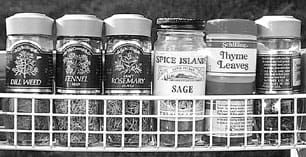By Gregory L. Tilford With new herbal products popping up like weeds on store shelves everywhere, it can be difficult to decide which ones are right for you and your dog. There are herbal remedies for immune system support, cardiovascular health, worms, fleas, nursing bitches, and dogs with urinary problems. Herbal products with cute and clever labels (most of which tell us nothing) have appeared on the shelves of health food stores, pet supply stores, even in mainstream supermarkets. Some of these products are very effective while others are nothing more than gimmicks that serve only to take your money. And as if things aren’t confusing enough, federal regulators currently prohibit even the best manufacturers from making reasonable and valid label claims about the intended uses of their products. I hope this will change soon. An organization of natural pet products manufacturers, called the National Animal Supplement Council (NASC), is drafting legislation intended to correct this problem. If it is passed, manufacturers of natural pet products will be able to better educate their customers by permitting limited structure and function claims on product labels. In other words, it will allow natural pet product manufacturers to tell you more about the intended purpose and uses for their products. Until then, the job of learning which products are right for you and your animal companions is entirely up to you. Fortunately, a wealth of herbal information waits in every bookstore, and whether you know it or not, many of the most effective herbal remedies are already at your fingertips. In fact, they may be as close as the kitchen cabinet. Even the most experienced herbalists (myself included) sometimes fail to look in the kitchen when the need for an herbal remedy arises. “Kitchen herbs” seem lackluster – they are not as trendy or sexy as plant medicines with long, exotic-sounding names. Perhaps they just don’t appeal to the mental image of a wise old medicine woman carefully harvesting odd-looking berries from a dark, primeval forest. Nevertheless, some of the most useful and safest herbs for animals are stored in our kitchens. Here are a few of my favorites. Dill Dill is very good for relieving nausea and flatulence, especially when such maladies are secondary to a sudden change in diet, such as when your puppy swipes a tamale from your foolishly unattended dinner plate. The effectiveness of dill in this capacity is largely attributable to the plant’s numerous volatile oil constituents, which exhibit an anti-foaming action in the stomach, much like over-the-counter anti-gas remedies. The highest concentrations of these oils are held within the seeds of the plant, but the dried leaves and stems (the stuff you are likely to have in your kitchen) can be used, too. If your dog is belching something suspiciously reminiscent of what was supposed to be your dinner, and the problem appears to be getting worse, make a tea by steeping one tablespoon of dill seed in eight ounces of very hot water. After the tea has cooled, strain it and try direct-feeding two ounces of the liquid to your companion. If your dog doesn’t like the flavor, try adding the tea to his drinking water. Or if need be, disguise it as “yummy people food” by mixing it with some clear, low sodium broth instead of water. A sprinkling of ground dill seed on his food may also bring about symptomatic relief, but the liquid option tends to be more effective. Fennel Fennel seed represents another option for relief of gastric discomfort. A cooled tea works very well for this purpose; one teaspoon of the dried seeds in eight ounces of boiling water, steeped until cool. The tea can be fed at a rate of two to four tablespoons for each 20 pounds of your dog’s body weight, or it can be added to his drinking water, as generously as he will tolerate. A glycerin tincture also works very well, and allows the convenience of a smaller dosage for finicky animals; 10-20 drops (or more precisely, up to 0.75 ml) per 20 pounds of the animal’s weight, as needed. Fennel is high in vitamins C and A, calcium, iron, potassium, and varying amounts of linoleic acid. It is an especially good nutritional adjunct for dogs whose chronic indigestion cannot be attributed to a specific disease entity. Fennel also helps increase appetite, and freshens the breath – thanks to its antibacterial activity in the mouth – and by minimizing belching. Fennel also has estrogen-like properties, which may explain why the herb has been used for centuries to increase milk production in nursing mothers. Some herbalists find that fennel helps alleviate urinary incontinence in spayed dogs by acting on hormone imbalances that contribute to the problem. Rosemary Rosemary is an extremely useful herb. At the top of its medicinal attributes are nervine, antidepressant, antispasmodic, and carminative properties. These combine to make rosemary an excellent remedy for flatulent dyspepsia and other digestive problems that are secondary to general nervousness, excitability, or irritability. The rosmarinic acid contained in the plant is also believed to have painkilling properties, especially in situations where pinched nerves are suspected. In such instances 0.5 ml (about 1/8 tsp.) of the tincture can be given orally, as a starting dose, for each 20 pounds of a dog’s body weight, up to three times daily. Rosemary is also useful as general cardiovascular tonic, moderating and improving heart function and strengthening capillary structure. A cooled rosemary tea (two tablespoons to a quart of water) serves as a very good, pleasant smelling rinse for itchy skin, and because of the ursolic acid, rosemarinic acid, carnisol, and other antibacterial constituents it contains, the rinse can be very effective for relieving the symptoms of various bacterial infections of the skin. For itchy skin and fleas, cooled rosemary tea can be poured into the coat as a soothing, healing, flea-repellent rinse. Rosemary also has excellent anti-microbial properties inside or on your companion’s body. Scientific studies have shown that it is active against various types of fungi, as well as numerous Gram-positive and Gram-negative bacteria. This makes it useful in antibacterial skin and eye rinses, minor cuts and burns, and for fighting infections of the mouth, throat, and the urinary and digestive tracts. Rosemary essential oil is thought to stimulate the nervous system, and may have a worsening effect upon epileptic seizures. Although rosemary in its natural form contains only a small amount of essential oil, it is probably best to avoid this herb altogether if your companion is epileptic. If applied in concentrated form, the volatile oils in rosemary may cross placental barriers and can effect uterine contractions. Therefore, rosemary is not appropriate for use during pregnancy. Sage Sage is an excellent remedy for infection or ulceration of the mouth, skin, or digestive tract. Most of its antimicrobial activity is attributable to its content of thujone, a volatile oil that is effective against a wide variety of harmful bacteria. In the mouth, a strong sage tea or tincture is useful for treating or preventing gingivitis, as well as infection that may be secondary to injury or dental surgery. For mild bacterial or fungal infections, sage tea can be added to drinking water. Make it by steeping one tablespoon of the dried leaves in a cup of near-boiling water. Stir the mixture frequently until it has cooled to lukewarm. Strain out the plant material, but don’t discard it if you are treating a localized gum infection; it can be used as a poultice by applying the wet herb directly to the affected area. If your companion doesn’t like the taste of sage tea, try sweetening it with a little honey (which has healing properties as well). The sweetened tea can be fed at a rate of one fluid ounce per 20 pounds of your dog’s body weight, twice or three times daily. Used in the form of a rinse, sage tea is useful for bacterial or fungal infections of the skin, and is especially wonderful when mixed in equal parts with rosemary and thyme teas. Thyme Most of the medicinal activity in thyme is attributable to the volatile oils thymol and carvacrol. Thymol is a very good antiseptic for the mouth and throat, and useful for fighting gingivitis. In fact, thymol is used as an active ingredient in many commercial toothpaste and mouthwash formulas. Combined with thyme’s infection-fighting qualities are its antitussive and expectorant properties, making the herb useful for raspy, unproductive coughs that are secondary to fungal or bacterial infection. As an antispasmodic, thyme helps ease bronchial spasms that are related to asthma. A glycerin tincture, or an alcohol tincture that has been sweetened with honey, serves well for most internal applications; use one-quarter of a teaspoon (1ml) for each 30 pounds of your dog’s body weight, fed as needed up to twice daily. A cooled tea will work too, provided it has been brewed with near-boiling water to draw out the volatile oil constituents. One teaspoon for dogs, ¼ teaspoon for cats, fed directly into the mouth two to three times daily. For infections of the mouth or as a preventative against gingivitis, the tincture or a very strong tea can be directly applied to the gum lines or infected sites with a swab. A thyme tea skin rinse, made by steeping one tablespoon of the herb in one quart of near-boiling water) is useful for various fungal or bacterial infections of the skin, especially if combined with equal parts of chamomile tea. Chamomile is another kitchen herb that is so incredibly safe and useful, that I’ll devote an entire article to it in a future issue. -Greg Tilford is a well-known veterinary herbalist, lecturer, and author. He serves as a consultant and formulator to hundreds of holistic veterinarians throughout the world, and is CEO of Animal’s Apawthecary, a company that develops herbal products specifically for use in animals. He is author of four books on herbs, including All You Ever Wanted to Know About Herbs for Pets (Bowtie, 1999), which he co-authored with his wife, Mary.
The best in health, wellness, and positive training from America’s leading dog experts
© Belvoir Media Group, LLC. All rights reserved.






